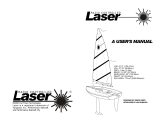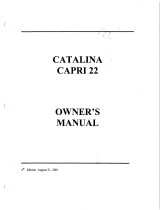Page is loading ...

Hobie Tiger Tuning Guide - 2006 Edition - Mitch Booth 15/03/2006
Tuning Guide
MAST SET UP
Mast set up is critically important to the performance of the boat.
Firstly set the spreader rake to suit your crew weight. Spreader Rake is measured
between a line between the tips of the spreaders and the back edge of the mast (as
shown diagram 1).
Spreader rake that is perfectly suited to you can only be determined by practice and
experiencing different conditions however this is what I go by as a rough guide:
♦ 40 – 54mm Spreader Rake For Medium Heavy Crews (155 – 170kg)
♦ 55 – 64mm Spreader Rake for Moderate Crews (141 – 154kg)
♦ Over 65mm Spreader rake for light crews (under 140kg)
The principle is to increase spreader rake for lighter crews and reduce for heavier
crews between this basic range.
Once deciding upon a suitable spreader rake tension the diamond wires. The
diamond wires can be adjusted to suit the conditions. The method I use to measure the
tension is using a Wire Tension Gauge which you can obtain from a local yacht shop.
Measuring the pre-bend is preferred by some people but if you adjust the tension
between races it is impossible to measure the pre-bend. This is where the tension
gauge comes in handy.
The settings I usually follow are:
♦ Under 36 for light wind (under 8 knots)
♦ 36 – 38 for medium wind (8 – 18 knots)
♦ 39 – 42 for strong wind (over 18 knots)
Basically I wind the diamond wires up to de-power (increases mast bend) and reduce
diamond wire tension to power up (reducing mast bend).
To test whether I have the correct mast set up I go sailing against another boat or boats
and go testing. I look for height, speed and power against the other boat. I find if I am
slower than the other boat, possibly struggling to hold the boat flat and having to point
very high (assuming the other variables are eliminated) the sail is too full. Increasing
Cunningham and reducing rotation comes to a limit and if I reach the limit before
reaching the same speed I increase the diamond tension to further bend the mast. If still
we are slow after reaching maximum diamond wire tension I then adjust the spreader
rake, which of course can only be done on the beach.
This then works in reverse also. If I find the boat is underpowered, maybe not
flying a hull when the other boats are, or fells sluggish and does not accelerate when
even without Cunningham and maximum rotation reducing the diamond wire tension will

Hobie Tiger Tuning Guide - 2006 Edition - Mitch Booth 15/03/2006
help. But this also can only go so far and if the diamond wires become too loose you risk
damaging your mast so then reducing spreader rake is the go. This will straighten the
mast and increase sail depth and therefore power.
BATTENS
I recommend using the battens supplied with the sail. The top two really
should only need to be adjusted with slightly lighter or heavier battens
depending on crew weight and conditions. Again it is the same, more power needed –
use softer battens, too much power – use harder battens.
The batten tension although not super critical should be done with some care.
I simply start at the top and pull the wrinkles out and then pull some more tension.
Pulling the batten tension too tight is not necessary.
JIB
Once hoisting the jib attach the tack as low as possible on the bridle fitting then look for
the sheeting angle from the clew to the track. I find an angle slightly higher the 45°
works . Then I estimate where on the Clew plate (where the sheet attaches).
After positioning the Jib correctly adjust the luff tension to suit the conditions.
This works same as the Cunningham on the Mainsail. Increase the tension in strong
wind conditions, and reduce tension in light conditions. In strong wind simply increase
tension to remove wrinkles then pull a little more till the luff is flat and firm.
Do not worry about having small wrinkles in the luff of the sail in light wind, it is not a
problem…….Don’t forget that you can adjust the luff tension of the jib between races if
you are not happy!
SPINNAKER
One of the most important things with the spinnaker is to ensure that it won’t have a
problem being hoisted, gybed or dropped. Ensure the all sharp edges, rings etc are well
taped and over the turnbuckles and anything that sticks out of the mast.
Attach the spinnaker lines and hoist it to ensure that everything is correct before starting
the race. The spinnaker can increase power by moving the block forward or using a
deflector block to change the sheeting angle. The further forward the more power is
generated. This can be adjusted for wind conditions.
RIG TENSION
A lot of people set the rig tension the same for all conditions. On a rotating rig
it is important to remember that as the mast rotates the leeward shroud is bearing
against the leeward side of the mast. This can create problems when you try to over
rotate downwind and in particular in light wind when there is no assistance from the sail
to push the mast. We all know that the leeward shroud goes slack while going upwind
even in moderate wind so all rig tension is doing is holding the mast slightly more

Hobie Tiger Tuning Guide - 2006 Edition - Mitch Booth 15/03/2006
vertical. I recommend very loose rig tension in light winds under 8 knots and slowly
increasing as the wind does (loose means that the wire is straight not flopping
while on the beach).
MAST RAKE
The mast rake using the trapeze measurement method (taking the trapeze to the
forstay bridle fitting and then swinging it aft to a point on the rear deck) . The range is
somewhere between the from of the inspection hatch and 10 cm down the transom. For
light winds further forward and heavier wind more aft. The crew weight is also a factor
and for light crews further aft and heavier crews generally a little forward.
RUDDER ALIGNMENT
Most common advice is to set the rudders up parallel however this may not be
the fastest. Most boats sail with some weather helm on the rudders and subsequently
you have to pull on the tiller slightly to keep the boat in a straight line going upwind, this
means you could have a few degrees of turn on the leeward rudder that is fully loaded,
however the windward rudder that has very little load will only cause drag if it is not in
line with the windward centerboard. The best way to assess what amount of toe in you
require is to sail upwind double trapeze under maximum load and watch the water flow
around the windward rudder.
When toeing in any rudders keep in mind that it should be the bare minimum as
excessive toe in will harm downwind performance when both rudders are not loaded and
close to parallel is fastest (see diagram 3).
Helm is directly related to rudder rake and if you have too much weather helm (pull on
the tiller) then the rudder may have to be kicked under the boat more and if you have
neutral helm it may need to be raked aft.
Attached diagrams:
2 – Rudder set up
1 – Mast spreader rake

Hobie Tiger Tuning Guide - 2006 Edition - Mitch Booth 15/03/2006
Mast Spreader Rake
Rudder set-up
String
Mast
Rudders up
/




